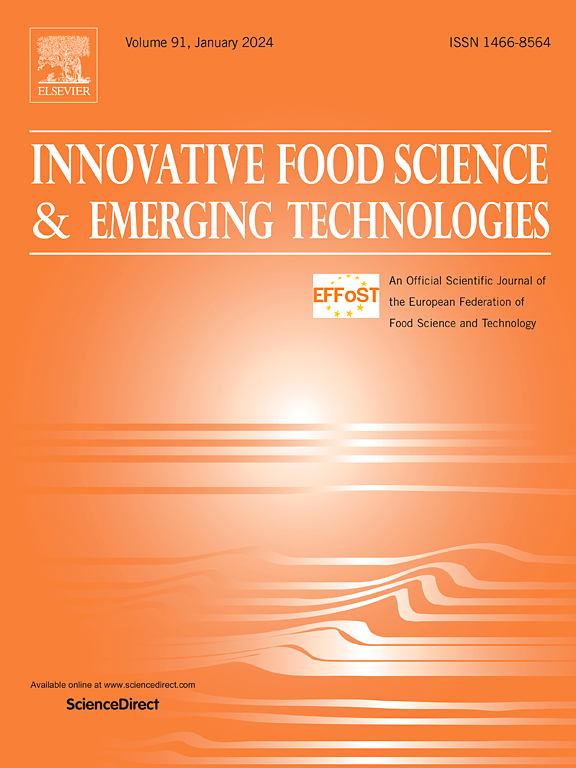介质阻挡放电产生的包装内非热等离子体灭活微生物动力学
IF 6.3
1区 农林科学
Q1 FOOD SCIENCE & TECHNOLOGY
Innovative Food Science & Emerging Technologies
Pub Date : 2025-01-19
DOI:10.1016/j.ifset.2025.103932
引用次数: 0
摘要
将接种在营养琼脂上的大肠杆菌和金黄色葡萄球菌装在聚乙烯袋中,用环境空气或Ar/O2混合物包装,用介质阻挡放电产生的非热等离子体(NTP)处理。直接计数存活细胞菌落以研究微生物失活动力学。结果表明,Weibull和双相模型充分描述了与功率水平、气体类型、处理时间、细菌种类和初始细胞浓度有关的失活动力学。在22.0 W的条件下,在初始细胞/培养皿6对数的氩气/氧气混合物下,在5分钟内,目标微生物减少了大约5对数。有趣的是,每种微生物在不同的初始细胞浓度(分别为6和5 log细胞/平板,相当于4.2和3.2 log CFU/cm2)下,对大肠杆菌和金黄色葡萄球菌的耐药性都急剧增强。尽管结果中出现了不均匀的微生物失活,可能是由于等离子体扩散有限,但包装内NTP处理仍然是一种有前途的、节能的、非热的微生物控制方法。本研究研究了介质阻挡放电产生的包装内非热等离子体处理的微生物失活动力学,该处理易于扩展到工业水平。了解这些动力学有助于确定适当的处理参数,如电输入功率和处理时间。采用氩气/氧气混合物进行大气改性,降低了工艺所需的能量,大大提高了微生物灭活效果。此外,良好的卫生习惯将促进治疗,因为微生物负荷影响失活率在本研究中证明。本文章由计算机程序翻译,如有差异,请以英文原文为准。
Kinetics of microbial inactivation using in-package nonthermal plasma generated by dielectric barrier discharge
Escherichia coli and Staphylococcus aureus inoculated on nutrient agar were packaged in polyethylene bags with ambient air or Ar/O2 mixture and treated with in-packaged nonthermal plasma (NTP) generated by dielectric barrier discharge. Surviving cell colonies were directly counted to investigate microbial inactivation kinetics. The results showed that Weibull and biphasic models adequately described inactivation kinetics, which depended on power level, gas type, treatment time, bacteria species, and initial cell concentration. Approximately 5-log reduction of the targeted microbes was achieved within 5 min at 22.0 W with argon/oxygen mixture at 6-log initial cell/plate. Interestingly, each microorganism drastically gained heightened resistance at different initial cell concentrations being 6 and 5-log cell/plate, equivalent to 4.2 and 3.2-log CFU/cm2, for E. coli and S. aureus, respectively. Although uneven microbial inactivation occurred in the results, likely due to limited plasma diffusion, in-package NTP treatment remains a promising, energy-efficient, nonthermal method for microbial control.
Industrial relevance
This study investigated the microbial inactivation kinetics of in-package nonthermal plasma treatment generated by dielectric barrier discharge which can be easily scaled into industry level. Understanding these kinetics helps determine appropriate processing parameters such as electrical input power and treatment time. Atmospheric modification by using argon/oxygen mixture reduced the energy required in the process and greatly improved the microbial inactivation effect. In addition, good hygiene practice would facilitate the treatment since microbial load affects the inactivation rate as demonstrated in this study.
求助全文
通过发布文献求助,成功后即可免费获取论文全文。
去求助
来源期刊
CiteScore
12.00
自引率
6.10%
发文量
259
审稿时长
25 days
期刊介绍:
Innovative Food Science and Emerging Technologies (IFSET) aims to provide the highest quality original contributions and few, mainly upon invitation, reviews on and highly innovative developments in food science and emerging food process technologies. The significance of the results either for the science community or for industrial R&D groups must be specified. Papers submitted must be of highest scientific quality and only those advancing current scientific knowledge and understanding or with technical relevance will be considered.

 求助内容:
求助内容: 应助结果提醒方式:
应助结果提醒方式:


